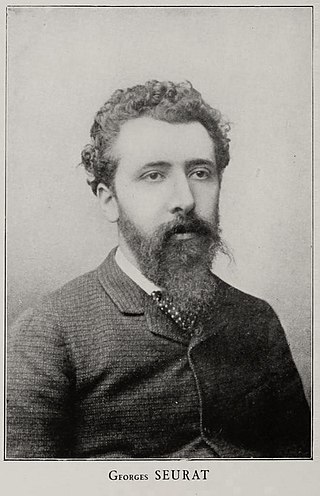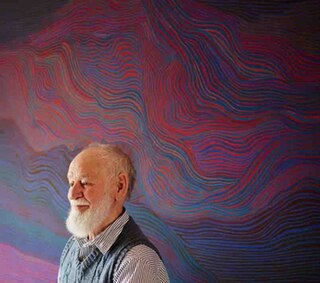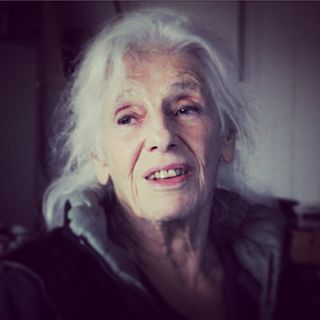
An impossible object is a type of optical illusion that consists of a two-dimensional figure which is instantly and naturally understood as representing a projection of a three-dimensional object but cannot exist as a solid object. Impossible objects are of interest to psychologists, mathematicians and artists without falling entirely into any one discipline.

Georges Pierre Seurat was a French post-Impressionist artist. He devised the painting techniques known as chromoluminarism and pointillism and used conté crayon for drawings on paper with a rough surface.

Op art, short for optical art, is a style of visual art that uses optical illusions.

Victor Vasarely was a Hungarian-French artist, who is widely accepted as a "grandfather" and leader of the Op art movement.

Josef Albers was a German-born American artist and educator who is considered one of the most influential 20th-century art teachers in the United States. Born in 1888 in Bottrop, Westphalia, Germany, into a Roman Catholic family with a background in craftsmanship, Albers received practical training in diverse skills like engraving glass, plumbing, and wiring during his childhood. He later worked as a schoolteacher from 1908 to 1913 and received his first public commission in 1918 and moved to Munich in 1919.

Julian Stanczak was a Polish-born American painter and printmaker who was one of the central figures in the Op art movement in the U.S. during the 1960s and 1970s. Described as an artist whose work "evinced a tremendous geometric inventiveness", Stanczak is primarily known for his polychromatic abstract paintings made using acrylic on canvas which rely on an interplay between geometric forms and lines.

Anne Truitt, born Anne Dean, was an American sculptor of the mid-20th century.

Anamorphosis is a distorted projection that requires the viewer to occupy a specific vantage point, use special devices, or both to view a recognizable image. It is used in painting, photography, sculpture and installation, toys, and film special effects. The word is derived from the Greek prefix ana-, meaning "back" or "again", and the word morphe, meaning "shape" or "form". Extreme anamorphosis has been used by artists to disguise caricatures, erotic and scatological scenes, and other furtive images from a casual spectator, while revealing an undistorted image to the knowledgeable viewer.

Don Eddy is a contemporary representational painter. He gained recognition in American art around 1970 amid a group of artists that critics and dealers identified as Photorealists or Hyperrealists, based on their work's high degree of verisimilitude and use of photography as a resource material. Critics such as Donald Kuspit have resisted such labels as superficially focused on obvious aspects of his painting while ignoring its specific sociological and conceptual bases, dialectical relationship to abstraction, and metaphysical investigations into perception and being; Kuspit wrote: "Eddy is a kind of an alchemist … [his] art transmutes the profane into the sacred—transcendentalizes the base things of everyday reality so that they seem like sacred mysteries." Eddy has worked in cycles, which treat various imagery from different formal and conceptual viewpoints, moving from detailed, formal images of automobile sections and storefront window displays in the 1970s to perceptually challenging mash-ups of still lifes and figurative/landscapes scenes in the 1980s to mysterious multi-panel paintings in his latter career. He lives in New York City with his wife, painter Leigh Behnke.

Josephine Gail Baer is an American painter associated with minimalist art. She began exhibiting her work at the Fischbach Gallery, New York, and other venues for contemporary art in the mid-1960s. In the mid-1970s, she turned away from non-objective painting. Since then, Baer has fused images, symbols, words, and phrases in a non-narrative manner, a mode of expression she once termed "radical figuration." She lives and works in Amsterdam, Netherlands.
Perceptual art is a form of art that can trace its roots to the art history concepts of perceptualism as well as to twentieth century inventions of conceptual art and performance art.
Anna P. Baker was a Canadian visual artist.

Russian Ballet is an artist's book by the English artist David Bomberg published in 1919. The work describes the impact of seeing a performance of Diaghilev's Ballets Russes, and is based on a series of drawings Bomberg had done around 1914, while associated with the Vorticist group of avant-garde artists in London. Centred on Wyndham Lewis and Ezra Pound, the movement flourished briefly from 1914–1915, before being dispersed by the impact of the First World War. The only surviving example of a vorticist artist's book, the work can be seen as a parody of Marinetti's seminal futurist book Zang Tumb Tumb, using similar language to the Italian's work glorifying war, but instead praising the impact of watching the decidedly less macho Ballets Russes in full flow.
Bomberg was the most audacious painter of his generation at the Slade, proving ... that he could absorb the most experimental European ideas, fuse these with Jewish influences and come up with a robust alternative of his own. His treatment of the human figure, in terms of angular, clear-cut forms charged with enormous energy, reveals his determination to bring about a drastic renewal in British painting. —Richard Cork

Horace Day, also Horace Talmage Day, was an American painter of the American scene who came to maturity during the Thirties and was active as a painter over the next 50 years. He traveled widely in the United States and continued to explore throughout his life subjects that first captured his attention as an artist in the Thirties. He gained early recognition for his portraits and landscapes, particularly his paintings in the Carolina Lowcountry.
In art criticism of the 1960s and 1970s, flatness described the smoothness and absence of curvature or surface detail of a two-dimensional work of art.

Edna Andrade was an American abstract artist. She was an early Op Artist.
Eusebio Sempere Juan was a Spanish sculptor, painter, and graphic artist whose abstract geometric works make him the most representative artist of the Kinetic art movement in Spain and one of Spain's foremost artists. His use of repetition of line and mastery of color to manipulate the way light plays on the surface give depth to his pictorial compositions.

Julianne Swartz is a New York-based artist. She is known for immersive installations, architectural interventions and sculptures that bring sound, optics and kinetics into play to create alternative, multisensory experiences. She uses utilitarian materials to warp, reshape or deepen perception, generating unexpected, ephemeral and participatory experiences out of common situations. Critics suggest that her work inhabits liminal areas, both literally and conceptually, bridging the perceptible and evanescent, public and private, visual and embodied, affective and technical. Art in America critic Peter R. Kalb wrote, "Swartz appeals to the senses and emotions with a quiet lyricism, using unassuming materials and marshaling grand forces like wind and magnetism" to offer "a thoughtful excursion into sound, sight and psyche."

Victor George Kord is an American painter and educator. He currently maintains a studio and exhibits in New York City. He previously served as art department chair for several major universities, and remains professor emeritus of painting at Cornell University Department of Art.
Edwin "Ed" Mieczkowski was an American visual artist and painter associated with the op-art movement in the U.S. He was one of the co-founders of the Anonima group along with Francis Hewitt and Ernst Benkert in Cleveland in 1960 and taught at the Cleveland Institute of Art from 1959 to 1998.















